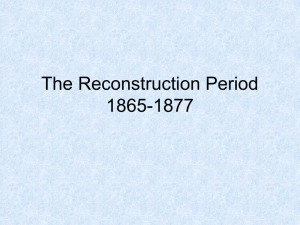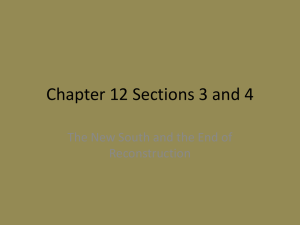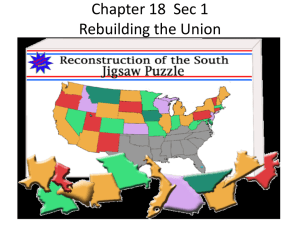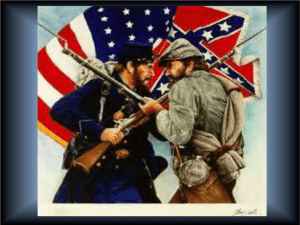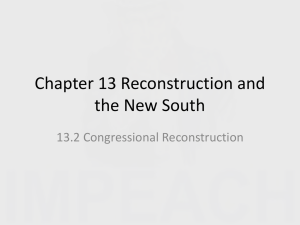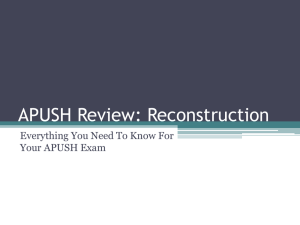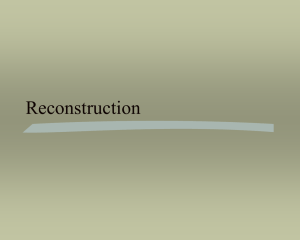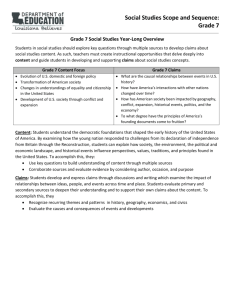AP31 Reconstruction
advertisement
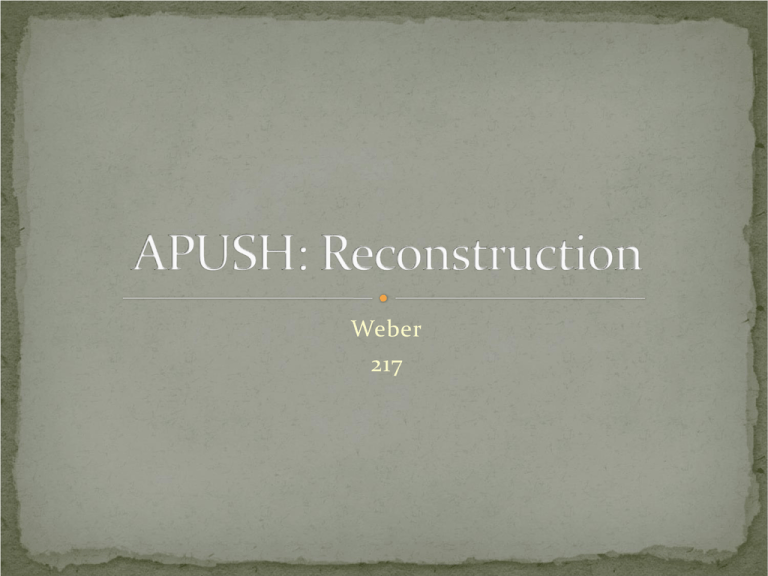
Weber 217 Take out your storyboard projects. 1. What is the theme of your film in one sentence? 2. Why did you choose this set of images? 3. What was the most interesting/important/valuable thing you learned through this project? You will have 3-5 minutes to pitch your movie to the class and to teach us about your images. Take a moment to prepare your presentation. Activator, agenda, and objective (10 minutes) Civil War storyboard presentations (45 minutes) The grant synthesis (15 minutes) Ch. 15 Reconstruction overview notes (30 minutes) Eric Foner video clips (15 minutes) Images from Reconstruction visual tour (15 minutes) Independent reading (time remaining) Exit ticket and homework (5 minutes) AP Topic #12: Reconstruction Presidential and Radical Reconstruction Southern state governments: aspirations, achievements, failures Role of African Americans in politics, education, and the economy Compromise of 1877 Impact of Reconstruction You have 3-5 minutes each. Explain the film you would make on the Civil War and your rationale for each of the images you selected to represent your scenes. Teach us the important facts about the Civil War you learned through completing the project. Class is expected to take detailed notes on each presentation. In your projects you made a storyboard with a series of images representing the scenes in your film. Now, take each presentation to represent a scene in a larger film. Write a synthesis that describes in your own words what that movie would look like, including supporting details from each of the presentations. 1. What did Fredrick Douglass mean when the insisted that “slavery is not abolished until the black man has the ballot.” 2. What explains the split of the women’s movement into two separate national organizations? 3. What meanings of freedom were most important to the freed slaves? 4. What were the arguments for and against land distribution for the freed slaves? 5. Why was Reconstruction brought to an end in 1877? The chapter begins with Special Field Order 15: “40 acres and a mule” for freedmen issues by gen. Sherman. It explores what freedom meant and how white American society responded to emancipation. Land ownership became a major issues as Black people were essentially denied free access to land. Reconstruction politics included three different approaches toward the South: Andrew Johnson’s plan was too lenient on the South Lincoln’s Ten Percent Plan was moderate The Radical Republican’s plan led by Thaddeus Stevens was truly ground breaking (“Radical Reconstruction”). Andrew Johnson pardoned many ex-Confederates and the South implemented Black Codes. The Radical Republicans in Congress fought back with the Civil Rights Act of 1866, the 14th Amendment, and the Military Reconstruction Act. Johnson didn’t want to let it happen and was impeached by the House (but avoided being removed from office by the Senate). The 15th Amendment was the completion of the agenda for Radical Reconstruction, but split the feminist movement because it failed to give the vote to women. Elizabeth Cady Stanton’s frustration over the 15th Amendment is shown in her writing chastising abolitionist Gerrit Smith for refusing to sign the women’s suffrage petition. Reconstruction shaped Southern politics as African Americans help over 2,000 political offices. Many white Southerners, however, felt threatened by Black suffrage, and the KKK began a campaign of reactionary white racism consisting or terror and violence. After the Klan was outlawed through the efforts of President Grant, the South began to take matters into their own hands and began a campaign to “redeem” the South from the perceived corruption, misgovernment, and combined Northern and Black control. Reconstruction ended in 1877, after a compromise was made between Republicans and Democrats on the presidential election of 1876. 15 week progress reports came out today. 1. What are you most proud of in terms of your work in this class? 2. Are you happy with how you are doing? 3. What specific things can you do to improve your understanding of the material, potential to excel on the AP exam, and your grade in the class? 4. What feedback do you have for me about what works well for you and what does not work so well in terms of your learning style and my teaching style? Activator, agenda, and objective (10 minutes) Literacy test (10 minutes) Reconstruction slideshow (30 minutes) Reconstruction group reading (30-45 minutes) Midterm exam: study guide (time remaining) Exit ticket and homework (5 minutes) Dr. Chau has found a literacy test that he thinks will be a measure of success in college as well as overall intelligence. He has asked that all Juniors take it before they are allowed to apply for colleges in order to help the counselors match you all with the right schools. It is timed and you only have 10 minutes. Good luck! Tests like this were used to disenfranchise African American voters in the South after Reconstruction. The one you just took is a Louisiana literacy test which you had to pass in order to vote. Literacy tests were used to deny citizens of their 15th amendment right all the way up until the 1960s!



